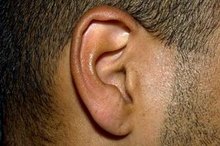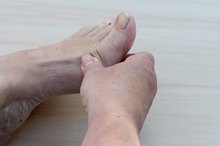5 Things That Cause Pain Behind the Ear and Down the Neck
Numerous conditions can cause pain behind the ear and down the neck, ranging from a pinched nerve to a more serious bone infection.
If you are experiencing serious medical symptoms, seek emergency treatment immediately.
Pain behind the ear is often associated with neck pain, as the tendons of many neck muscles connect to the mastoid process — a prominent bony bump — located just behind the ear.
If you're experiencing this kind of pain, keep in mind that neck pain can travel to other parts of the body as well, such as the shoulders, arms and head, according to MedlinePlus, a publication of the National Institutes of Health 12. In some cases, the reverse is true: Pain in various parts of the head can radiate to your neck.
With all that in mind, here are five possible causes of behind-the-ear and neck pain that you should know about.
1. Cervicogenic Headache
A cervicogenic headache, sometimes called a cervical headache, may cause a dull, aching pain throughout the head as well as behind the ear and down the neck.
According to the American Migraine Foundation, a cervicogenic headache is referred pain, which means the pain is actually coming from the neck, but you end up feeling it in your head 4. The cause of this headache is a disorder of the cervical spine and its surrounding bone, disc and/or soft tissues.
Possible causes of cervicogenic headache include nerve compression between the vertebrae or spinal bones, excessive tenderness in the neck tissues due to trigger points — hyper-irritable nodules or knots within a tight band of muscle — and reduced range of motion or a stiff neck.
Most cervicogenic headaches respond well to chiropractic manipulation, massage therapy, acupuncture and postural retraining exercises.
- A cervicogenic headache, sometimes called a cervical headache, may cause a dull, aching pain throughout the head as well as behind the ear and down the neck.
- Possible causes of cervicogenic headache include nerve compression between the vertebrae or spinal bones, excessive tenderness in the neck tissues due to trigger points — hyper-irritable nodules or knots within a tight band of muscle — and reduced range of motion or a stiff neck.
2. Mastoiditis
4 Possible Causes of Aching Ears and Headaches
Learn More
According to MedlinePlus, mastoiditis is an infection of the mastoid bone of the skull, which is located directly behind the pinna, or outside portion of the ear 12.
"The mastoid bone houses the ear structures, though we're not 100 percent sure why we have it in our bodies," Lawrence Lustig, MD, otolaryngologist-in-chief at NewYork-Presbyterian/Columbia University Medical Center in New York City, tells LIVESTRONG.com 5. Two possible theories: the mastoid bone may act as an air cushion to the brain, or it could provide ventilation to the middle ear.
The most common cause of mastoiditis is a middle ear infection 2. The infection can spread from the ear to the mastoid bone, causing infected materials to accumulate within the mastoid air cells — a network of honeycomb-like structures within this bone. Infection of the mastoid air cells can cause destruction and degeneration of the bony tissue that composes this part of the skull.
Mastoiditis affects children more often than adults 2. Beyond ear and neck pain, common signs and symptoms associated with this condition include:
- Head and neck discomfort
- Pain and swelling behind the ear
- Ear drainage
- Fever
- Headache
- Hearing loss
- Redness of the affected area
- According to MedlinePlus. "
- Two possible theories: the mastoid bone may act as an air cushion to the brain, or it could provide ventilation to the middle ear.
3. Whiplash
Whiplash is another source of this specific type of pain.
According to the National Institute of Neurological Disorders and Stroke (NINDS), whiplash is a collection of symptoms that occur following rapid movement and/or an extension injury of the neck 38. The most common cause of whiplash is a rear-end motor vehicle accident.
Whiplash symptoms range from mild to severe. Moderate or severe cases of whiplash usually involve extensive soft tissue damage to neck muscles, tendons, ligaments and nerve roots.
Common signs and symptoms associated with whiplash include:
- Neck pain and stiffness
- Pain behind the ears
- Neck muscle strains
- Neck ligament sprains
- Headache
- Dizziness
- Shoulder pain
- Back pain
- Memory loss
- Inability to concentrate
- Irritability
- Fatigue
- Sleeping problems
- Depression
The NINDS states that, although most people who suffer a whiplash injury recover within three months, some people may experience residual symptoms that last much longer. For this reason, it's important to see a doctor if you're suffering from this condition.
- Whiplash is another source of this specific type of pain.
- The most common cause of whiplash is a rear-end motor vehicle accident.
4. Pinched Nerve
Causes of Pain on the Right Side of the Neck Down to the Shoulder
Learn More
Another common cause of pain behind the ear that radiates down the neck is a pinched nerve, says Dr. Lustig.
The American Academy of Orthopaedic Surgeons describes a pinched nerve, or cervical radiculopathy, as a nerve near the spinal cord that has become compressed or irritated 6. This condition is typically caused by aging and arthritis, though in younger people a pinched nerve can result from an injury involving a herniated disk.
To ease this pain, you may be advised by your physician to wear a soft surgical collar, practice specific exercises to strengthen the neck muscles and take nonsteroidal anti-inflammatory drugs such as ibuprofen or naproxen.
- Another common cause of pain behind the ear that radiates down the neck is a pinched nerve, says Dr. Lustig.
- This condition is typically caused by aging and arthritis, though in younger people a pinched nerve can result from an injury involving a herniated disk.
5. Temporomandibular Joint Syndrome (TMJ)
TMJ pain is a very common cause of head, ear and neck pain that may be triggered by arthritis, a jaw injury or frequent teeth grinding or clenching.
If you have TMJ, you might feel pain while chewing food, discomfort near the ear and tenderness around the jaw bone, per the Mayo Clinic 7.
"There's also a strong link between TMJ pain and migraines," points out Dr. Lustig.
To treat this pain, try warm compresses at the pain site and over-the-counter medications such as Motrin or Advil. For people who grind their teeth at night, a bite guard may also be recommended, says Dr. Lustig.
- TMJ pain is a very common cause of head, ear and neck pain that may be triggered by arthritis, a jaw injury or frequent teeth grinding or clenching.
- If you have TMJ, you might feel pain while chewing food, discomfort near the ear and tenderness around the jaw bone, per the Mayo Clinic. "
Related Articles
References
- MedlinePlus: "Neck Pain"
- MedlinePlus: "Mastoiditis"
- National Institute of Neurological Disorders and Stroke: "Whiplash Information Page"
- American Migraine Foundation: "Cervicogenic Headache"
- Lawrence Lustig, MD, otolaryngologst
- American Academy of Orthopaedic Surgeons: "Cervical Radiculopathy (Pinched Nerve)"
- Mayo Clinic: "TMJ Disorders"
- US National Library of Medicine: "Neck Injuries and Disorders"
- American Academy of Orthopedic Surgeons. Cervical Fracture (Broken Neck). Reviewed December 2013.
- Moley PJ. Evaluation of Neck and Back Pain. Merck Manual. Updated August 2019.
- Cleveland Clinic. Think You Might Have Whiplash? Know the Symptoms. Updated January 2, 2017.
- Singh S, Kumar D, Kumar S. Risk factors in cervical spondylosis. J Clin Orthop Trauma. 2014;5(4):221-6. doi:10.1016/j.jcot.2014.07.007
- American Academy of Orthopaedic Surgeons. Cervical spondylosis (Arthritis of the Neck). Updated August 2015.
- ScienceDirect. Discogenic Pain: Treatment of Lumbar Discogenic Pain. 2009.
- Columbia University Department of Neurology. Cervical Spondylosis.
- Touma J, May T, Isaacson AC. Cervical Myofascial Pain. Treasure Island, FL: StatPearls Publishing. Updated September 13, 2019.
- World Health Organization. Spinal Cord Injury. 2013.
- Centers for Disease Control and Prevention. Meningococcal Disease: Signs & Symptoms. Updated June 7, 2017.
- National Institute of Neurological Disorders and Stroke. Meningitis and Encephalitis Fact Sheet. Updated August 13, 2019.
- Stanford Children's Health, Lucile Packard Children's Hospital. Meningitis in Children.
- University of Southern California. Cervical Spine Infections.
- Cleveland Clinic. Salivary Gland Cancer. Updated October 13, 2018.
- Morris NA, Merkler AE, Gialdini G, Kamel H. Timing of incident stroke risk after cervical artery dissection presenting without ischemia. Stroke. 2017;48(3):551-555. doi:10.1161/STROKEAHA.116.015185
- Cleveland Clinic. Cervical (Carotid or Vertebral) Artery Dissection. Updated May 24, 2019.
- Eubanks JD. Cervical radiculopathy: nonoperative management of neck pain and radicular symptoms. Am Fam Physician. 2010;81(1):33-40.
- Khare S, Seth D. Lhermitte's sign: The current status. Ann Indian Acad Neurol. 2015;18(2):154-6. doi:10.4103/0972-2327.150622
- American Academy of Orthopedic Surgeons. Cervical Radiculopathy: Surgical Treatment Options. Updated June 2015.
- American Academy of Orthopedic Surgeons. Cervical Fracture (Broken Neck). Reviewed December 2013.
- Chow AW. (2018). Deep neck space infections in adults. Durand MJ, ed. UpToDate. Waltham, MA: UpToDate Inc.
- Cohen SP. Epidemiology, diagnosis, and treatment of neck pain. Mayo Clinc Proc. 2015 Feb;90(2):284-99. doi:10.1016/j.mayocp.2014.09.008
- Isaac Z, Kelly HR. (2018). Evaluation of the adult patients with neck pain. Atlas SJ, ed. UpToDate. Waltham, MA: UpToDate Inc.
- Martinez-Perez R, Fuentes F, Alemany VS. Subaxial cervical spine injury classification system: is it most appropriate for classifying cervical injury? Neural Regen Res. 2015 Sep;10(9):1416-7. doi:10.4103/1673-5374.165508








